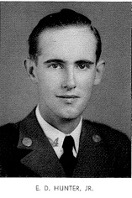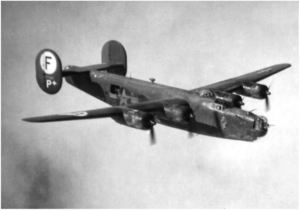Scroll of Honor – Eldon Douglas Hunter, Jr.
Lost
Written By Kelly Durham
These days, we take transoceanic flight for granted. With advances in aircraft  technology—from efficient jet engines to satellite navigation systems—air travel between continents is routine, with hundreds of flights departing and arriving each day. But, when the United States was plunged into World War II, air travel, particularly over the oceans, was still a novelty for most people. As the country mobilized its armed forces, particularly the Army Air Force, getting aircraft to bases from which they could engage the enemy became a high priority. Eldon Douglas Hunter, Jr., Clemson College Class of 1941, was one of the thousands of young men who would attempt to fly the Atlantic as a crew member of a heavy bomber.
technology—from efficient jet engines to satellite navigation systems—air travel between continents is routine, with hundreds of flights departing and arriving each day. But, when the United States was plunged into World War II, air travel, particularly over the oceans, was still a novelty for most people. As the country mobilized its armed forces, particularly the Army Air Force, getting aircraft to bases from which they could engage the enemy became a high priority. Eldon Douglas Hunter, Jr., Clemson College Class of 1941, was one of the thousands of young men who would attempt to fly the Atlantic as a crew member of a heavy bomber.
Hunter was a textile engineering major from Edisto Island. He worked on the staff of The Tiger, the campus newspaper, but served four years in the Corps of Cadets without advancing above the rank of private. Nonetheless, when war came, Hunter volunteered for the Army Air Force.
By early 1944, Hunter was a staff sergeant serving as the flight engineer on a B-24 Liberator heavy bomber. As flight engineer, Hunter was expected to be an expert on all the systems of the complex aircraft, particularly its four 1200 horsepower engines. From his position behind the pilots, Hunter would assist them in monitoring engine performance and fuel usage. He also served as the aircraft’s top turret gunner.
 Army officials developed two main routes for ferrying aircraft to the European Theater of Operations. The Northern Route originated from Army Air Bases in New England and continued along the Atlantic coast to Newfoundland, then to Labrador, Greenland, Iceland, and over the North Atlantic to airfields in Ireland and southwest England. The short days and harsh weather of winter in these northern climes called for an additional route. The southern route started from airfields in Florida. From these, aircraft would fly to Puerto Rico, Antigua, and Trinidad before reaching Atkinson Field, in British Guiana on the northeast coast of South America. Aircraft would then fly to fields in eastern Brazil, the closest portion of South America to the continent of Africa. Crossing the South Atlantic at this relatively narrow point reduced the flight time over water–and the risk.
Army officials developed two main routes for ferrying aircraft to the European Theater of Operations. The Northern Route originated from Army Air Bases in New England and continued along the Atlantic coast to Newfoundland, then to Labrador, Greenland, Iceland, and over the North Atlantic to airfields in Ireland and southwest England. The short days and harsh weather of winter in these northern climes called for an additional route. The southern route started from airfields in Florida. From these, aircraft would fly to Puerto Rico, Antigua, and Trinidad before reaching Atkinson Field, in British Guiana on the northeast coast of South America. Aircraft would then fly to fields in eastern Brazil, the closest portion of South America to the continent of Africa. Crossing the South Atlantic at this relatively narrow point reduced the flight time over water–and the risk.
On March 1, 1944, Hunter was the flight engineer on a B-24 piloted by First Lieutenant James Buchanan on a ferry flight from Waller Field in Trinidad. The aircraft took off shortly after six o’clock in the morning bound for Atkinson Field, 350 miles away across open water. Two hours later, Buchanan’s aircraft contacted Atkinson Field by radio to report it was on course. Nothing more was ever heard from the crew. A blimp-borne aerial search was mounted, by no sign of the aircraft or its crew was discovered.
Hunter is memorialized on the East Coast Memorial in New York for those missing in action or buried at sea.
For more information about Eldon Douglas Hunter, Jr. see:
https://soh.alumni.clemson.edu/scroll/eldon-douglas-hunter-jr/
For additional information about Clemson University’s Scroll of Honor visit:
https://soh.alumni.clemson.edu/
